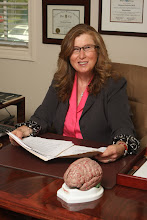Tomorrow's *New York Times* (Tuesday, May 26) includes an article: "ABrain Disorder Easily Missed" by Jane Brody.Here are some excerpts:
Edward Ferguson, a civil engineer living in Vancouver, Wash., retired atage 65 from a job handling multimillion-dollar contracts.Five years later he could not balance a checkbook, walk without falling,drive a car, control his bladder or recognize his granddaughter.Instead of the active retirement he had anticipated, Mr. Ferguson, now74, thought he would spend the rest of his life in a wheelchair,incontinent and struggling with dementia.
Ten doctors were unable to tell him what was wrong, but an Internetsearch by his daughter found a condition that seemed to match hissymptoms: normal pressure hydrocephalus, or N.P.H.
The disorder involves a build-up of spinal fluid in the ventricles ofthe brain, causing pressure on nerves that control the legs, balance,bladder and cognitive function."It's as if the brain has reverted to babyhood," Dr. Michael Kaplitt, aneurosurgeon at NewYork-Presbyterian Hospital/Weill Cornell MedicalCenter, said in an interview."Like babies, people with N.P.H. walk slowly with feet wide apart, theyare incontinent and have no memory."Dr. Kaplitt calls it "a classic triad of symptoms" that should alertdoctors to the possibility of N.P.H.Yet the condition is frequently misdiagnosed as dementia, Alzheimer'sdisease, Parkinson's disease or a spinal problem.Or it is attributed to age -- nearly all who are affected are over 55.
Two days after surgery to install a programmable shunt that relieved thepressure on the frontal lobes of his brain, Mr. Ferguson walked across aroom for the first time in a year.He was able to think and write clearly, and his incontinence improved.The Fergusons are now looking forward to their 56th anniversary. Mr.Ferguson, who had contemplated suicide, considers himself to have asecond chance at life."At one point I saw no light at the end of the tunnel," he said, "andnow it is just so beautiful there."
No one knows how often N.P.H. occurs because it is so often missed ormisdiagnosed. Estimates range from 50,000 to 375,000 people in theUnited States, with the higher figure more likely to be correct, saidDr. Mark Luciano, a neurosurgeon at the Cleveland Clinic."There are a lot of people out there with a correctable problem that isattributed to old age," Dr. Luciano said."When the problem is fixed, it's like rescuing them from oblivion.A small percentage of people with dementia -- maybe 10 or 15 percent --really have N.P.H."The disorder was recognized and named in 1965.But most doctors who treat older people are unaware of it or fail tothink of it when treating patients with classic, albeit confusing, symptoms.
Normal pressure hydrocephalus is best diagnosed by a team that includesa radiologist, neuropsychologist and neurologist or neurosurgeonexperienced in distinguishing this condition.
The best clue often comes from a careful medical history, since N.P.H.typically starts with gait problems, Dr. Luciano and his colleague, Dr.Ronan Factora, a geriatrician at the Cleveland Clinic, reported lastyear in the journal Geriatrics.Cognitive impairment typically does not precede gait problems, theysaid, but when it does, or when dementia has become severe, the responseto treatment is lessened. Incontinence, which starts out as urinary urgency, can occur at any pointin the disease, and is often worsened by problems with walking or dementia.
Although there is no one route to diagnosis, if N.P.H. is suspected, aCT scan or M.R.I. of the brain can reveal one or more enlargedventricles, an essential feature of the condition.On an M.R.I., Dr. Kaplitt said, the spinal fluid often is cloudy or turbulent.Treating N.P.H. involves inserting a shunt into the brain to drain offaccumulating spinal fluid and divert it to the abdomen, where it can bereabsorbed into the bloodstream.The ideal shunt has a valve and can be reprogrammed to regulate the drainage.Repeat surgery is a possibility if the shunt drains off too much or toolittle spinal fluid.While the shunt is not a cure for N.P.H., in the 70 to 80 percent ofpatients who benefit from it, it may give them a decade or more of near-normal life, the experts said
Tuesday, May 26, 2009
Subscribe to:
Post Comments (Atom)


No comments:
Post a Comment